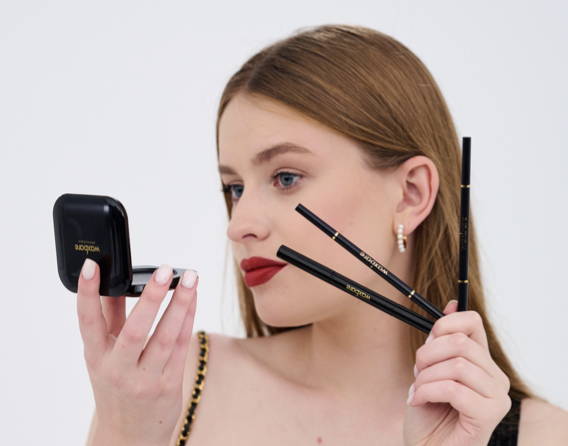
Eyebrows are an essential aspect of our facial features and can make a significant impact on our overall appearance. The shape of our eyebrows can frame our eyes and face, enhancing our natural beauty. In recent years, eyebrow shaping has become increasingly popular, with many people seeking to achieve perfectly sculpted and groomed eyebrows.
Whether you're looking to enhance your natural shape or completely transform your eyebrows, we are here to guide you through the process. We'll provide you with techniques and tips to help you achieve the classic eyebrow shape that works for everyone.
Whether you are creating eyebrows for yourself or someone else, it's helpful to understand the various components that make up the eyebrow shape.
Here are some important terms to know:
Center - The center point of the face between the eyes.
Bulb - The front portion of the eyebrow.
Top Front- The upper point of the beginning of the eyebrow, equally distanced from center for both eyebrows.
Bottom Front- The lower point of the beginning of the eyebrow equally distanced from center for both eyebrows.
Body - The middle part of the eyebrow.
Arch - Where the eyebrow curves.
Top Arch - The top point where the eyebrow starts to curve.
Bottom Arch- The lower point where the eyebrow starts to curve.
Tail - The ending of the eyebrow.
Tail Angle - The direction the tail points towards the ear.
Tail Point- The furthest point of the eyebrow.
Once you know the various areas of the eyebrow, you are ready to start mapping your design.

Step By Step to Mapping Symmetrical Eyebrows:
1. Using a pre-inked mapping string or a pencil, identify and mark the center point between the eyes.
2. Locate and mark the top and bottom fronts of the brows by points of the eyebrow. The brow fronts should start an equal distance from the center of each other with the points extending from the corner of the nostril though the inner corner of the eye. Keep in mind that the distance between the top and bottom front points will determine the thickness of your eyebrows.

3. To determine the top arch point, take your string or pencil and measure from the corner of the nose, extending through the center point of the eye.
4. The bottom arch point will extend 2-3 mm horizontally past the top arch point. The vertical distance between the top arch and the bottom arch will determine the intensity of the arch. When closer together, the body of the brow will narrow as it makes the arch and tail for a more dramatic arch. When spaced the same distance apart as the brow fronts the arch will be softer. Never allow the vertical distance between the top and bottom arch to be larger than the distance between the top and bottom front.

5 To determine tail location, use thread or a pencil to measure from the corner of the nose extending through the corner portion of the eye.
6. The tail angle can be determined by using string or a pencil to measure from either the middle of the ear or the top portion of the ear where it meets face. Try to follow closest to natural brow bone structure.

7. Connect all the points. Start with making a straight light from the top front point to the top arch point. Then draw another straight line from the bottom front point to the bottom arch point. Last, complete the tail by drawing a line from top arch point to tail point and from bottom arch point to tail point.
8. Cross check alignment horizontally across the face of tail points, bottom arches, top arches and both the top and bottom fronts to ensure they match on both sides.
9. Make subtle adjustments until the shape is to your liking.
10. Apply finishing touches to define the shape and complete the look.

Golden Rules:
1. Fuller brows are best for fuller lips and thinner brows are better for thinner lips.
2. The bulb can be slightly wider or equal in width to the body of the brow but never allow the bulb to be more narrow than the body and arch.
3. Tail point should not extend lower than the bottom front point when measured horizontally. The tail point and bottom front point should be equal across horizontally or slightly higher for a lifted effect.
4. The "2/3 to 1/3" Rule: The body of the brow, from the front to the arch area,
should make up the 2/3 of the total brow. The area from the arch to the tail point should make up 1/3 of the total brow.
Finishing Touches:
1.Wax or Tweeze any hair that falls outside of the design.
2. Style with Brow Elixir Balm: Available in medium and super hold.
3. Color in the eyebrows with desired makeup product. We recommend WAXBARE’s ultra fine pencil. These pencils are available in 5 colors and are complete with a blending brush on one end to allow for building or softening the finished look.

